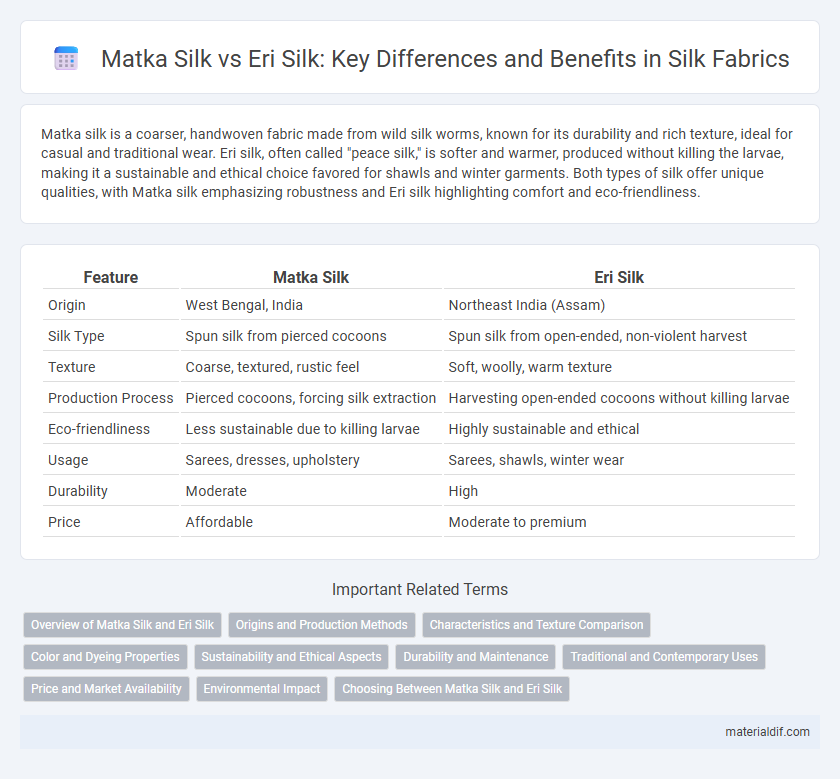Matka silk is a coarser, handwoven fabric made from wild silk worms, known for its durability and rich texture, ideal for casual and traditional wear. Eri silk, often called "peace silk," is softer and warmer, produced without killing the larvae, making it a sustainable and ethical choice favored for shawls and winter garments. Both types of silk offer unique qualities, with Matka silk emphasizing robustness and Eri silk highlighting comfort and eco-friendliness.
Table of Comparison
| Feature | Matka Silk | Eri Silk |
|---|---|---|
| Origin | West Bengal, India | Northeast India (Assam) |
| Silk Type | Spun silk from pierced cocoons | Spun silk from open-ended, non-violent harvest |
| Texture | Coarse, textured, rustic feel | Soft, woolly, warm texture |
| Production Process | Pierced cocoons, forcing silk extraction | Harvesting open-ended cocoons without killing larvae |
| Eco-friendliness | Less sustainable due to killing larvae | Highly sustainable and ethical |
| Usage | Sarees, dresses, upholstery | Sarees, shawls, winter wear |
| Durability | Moderate | High |
| Price | Affordable | Moderate to premium |
Overview of Matka Silk and Eri Silk
Matka silk, produced from wild Antheraea paphia silkworms, is known for its coarse texture, natural sheen, and breathable fabric ideal for traditional Indian garments. Eri silk, derived from Samia ricini silkworms, offers a soft, wool-like feel with excellent thermal insulation, making it suitable for cooler climates and eco-friendly textile applications. Both silks are valued for their sustainable production methods and distinct tactile properties that cater to diverse fashion and utility needs.
Origins and Production Methods
Matka silk originates primarily from Bihar, India, and is crafted using hand-spun yarn from tussar silk cocoons, producing a coarse texture with natural variations. Eri silk, also known as Ahimsa silk, comes mainly from Assam and Meghalaya and is produced by harvesting silk after the moth emerges, allowing for a non-violent process and resulting in a heavier, warmer fabric. Both silks involve traditional hand-weaving techniques but differ significantly in raw material processing and ethical considerations.
Characteristics and Texture Comparison
Matka silk is known for its coarse yet lightweight texture with a matte finish, making it durable and ideal for traditional Indian garments. Eri silk, often called "peace silk," has a softer, warmer feel with a wool-like texture, prized for its thermal insulation and eco-friendly production. While Matka silk's rougher texture suits casual wear, Eri silk's smooth and heavy drape fits premium winter clothing.
Color and Dyeing Properties
Matka silk is known for its natural dark, off-white to brown shades that easily absorb vibrant dyes, resulting in rich and deep colors. Eri silk features a creamy white base with a coarse texture, which offers excellent dyeing properties, especially for lighter and pastel hues. Both silks respond well to natural and synthetic dyes, but Matka silk's tighter weave enhances color retention and vibrancy over time.
Sustainability and Ethical Aspects
Matka silk, produced from wild silk moths, involves a natural and less harmful process that allows moths to emerge before cocoon harvesting, supporting biodiversity and ethical treatment. Eri silk, known as "peace silk," is renowned for its sustainable production, as it does not require killing the silk worms, aligning with cruelty-free and environmentally friendly practices. Both Matka and Eri silk offer eco-conscious alternatives to conventional silk, with lower environmental impact and stronger commitments to animal welfare.
Durability and Maintenance
Matka silk, produced from wild silk moths, offers moderate durability with a slightly coarse texture that requires gentle hand washing to maintain its sheen. Eri silk, known as the "fabric of peace," boasts higher durability due to its thicker yarns and is easier to maintain since it can withstand machine washing without significant damage. While Matka silk demands careful maintenance to preserve its delicate fibers, Eri silk stands out as a more resilient and low-maintenance option for everyday wear.
Traditional and Contemporary Uses
Matka silk, traditionally woven in Bihar, is prized for its coarse texture and natural dye absorption, making it ideal for ethnic sarees and home decor, while contemporary designers incorporate it into fusion wear and accessories. Eri silk, derived from the silk moth in Assam, is renowned for its durability and warmth, traditionally used in shawls and winter garments, and it has gained popularity in eco-friendly fashion for jackets and scarves. Both silks retain cultural significance and adapt to modern fashion trends with handcrafted and sustainable appeal.
Price and Market Availability
Matka silk is generally more affordable and widely available in the Indian market compared to Eri silk, which tends to be pricier due to its labor-intensive production process and limited supply. Eri silk's market presence is more niche, often found in specialty stores and premium textile boutiques, while Matka silk is commonly used in everyday garments and traditional wear. The price difference primarily reflects Eri silk's unique texture and sustainable, non-violent harvesting method, making it a luxury choice amid the growing demand for ethical fabrics.
Environmental Impact
Matka silk, produced from wild silk moths, generally has a lower environmental footprint due to its natural and sustainable harvesting process, which doesn't require killing the larvae. Eri silk, derived from domesticated eri silkworms, supports eco-friendly practices as it allows the moth to emerge naturally, promoting biodiversity and sustainable sericulture. Both silk types contribute to reducing synthetic textile pollution, but Matka silk's reliance on wild silk moths often enhances local ecosystems and forests preservation.
Choosing Between Matka Silk and Eri Silk
Matka silk, known for its coarse texture and durability, is ideal for traditional sarees and heavy embroidered fabrics, while Eri silk offers a soft, warm, and eco-friendly alternative often used in shawls and winter wear. Choosing between Matka and Eri silk depends on the intended use, with Matka silk preferred for its rougher, lustrous finish and Eri silk favored for comfort and thermal properties. Both silks showcase distinctive weaving techniques originating from Indian handloom traditions, making the choice a balance between aesthetics, texture, and seasonal functionality.
Matka silk vs Eri silk Infographic

 materialdif.com
materialdif.com